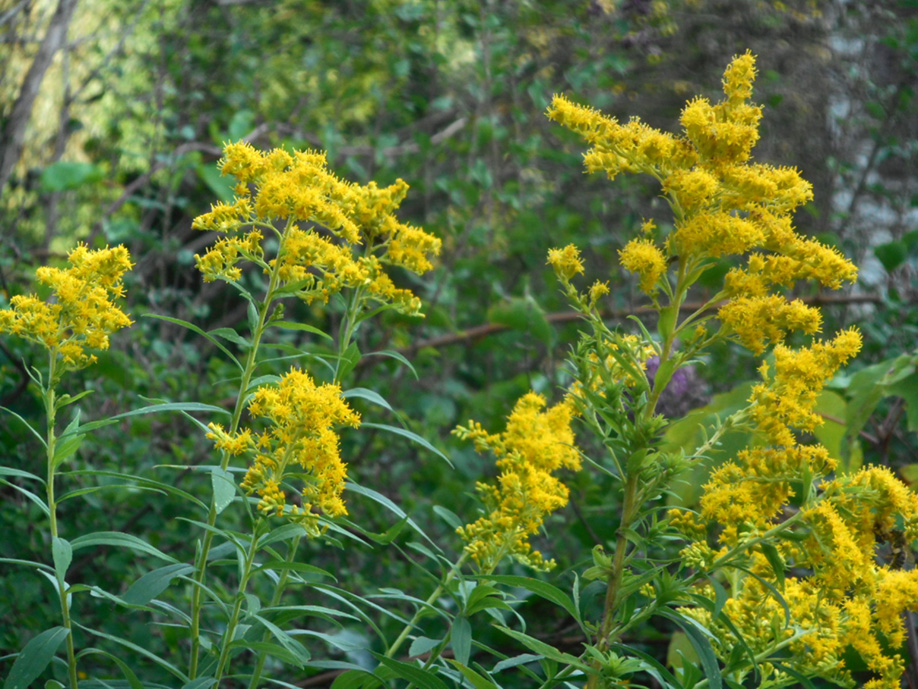
photo by Deborah J. Benoit
Goldenrod, which blooms during late summer and early fall, is not only an important food source for pollinators but can be used in herbal teas and to make natural dyes.
by Deborah J. Benoit, Extension Master Gardener
NORTH ADAMS, Mass. – Of all the wildflowers—or weeds, if you prefer—goldenrod (Solidago) is one of the most recognizable. Its plumes of bright yellow flowers atop tall stems bob in the breeze, making its presence hard to miss. If you have allergies, every time you drive by a stand of it growing along the roadside, you probably wish goldenrod would just go away.
Goldenrod blooms during late summer and early fall, the same time and likely in the same places as the real villain in all that sniffling and sneezing, ragweed (Ambrosia artemisiifolia). In a clear case of guilt by association and by being the flashier of the two, goldenrod gets blamed for the ills brought on by the usually overlooked ragweed.
Ragweed’s pollen sails easily on the breeze. Goldenrod’s pollen is heavier, stickier and relies on pollinators to spread.
Solidago, the scientific name for goldenrod, means to make whole. Flowers, leaves and stems have been made into herbal remedies for centuries. It’s been used in folk medicine to help heal wounds, as a diuretic, to treat inflammation, and as treatment for a variety of illnesses.
Historically, goldenrod took its place in America’s story when British tea was shunned after the Boston Tea Party and colonists turned to home grown berries and plants to create what were known as “liberty teas.” Goldenrod, fresh or dried, is still a popular ingredient in herbal teas today.
Adding to its versatility, goldenrod flowers can be used to create a natural dye. At their height of freshness, they yield a bright yellow while those turning to seed will result in a duller color.
A native plant found across the United States, goldenrod is a perennial, hardy to U.S. Department of Agriculture Plant Hardiness Zone 2. It grows between three and six feet tall, most enthusiastically in full sun. It dies back after the first frost, only to return again in the spring.
There are over 100 species of goldenrod. About a dozen species are found in Vermont.
Goldenrod is the state flower in Nebraska and Kentucky. In South Carolina, it’s the state wildflower. In Delaware, sweet goldenrod (Solidago odora) is the state herb.
Goldenrod makes itself at home in naturalized areas of yards and creates a colorful backdrop in the home garden in the fall. Its feathery flowers add fill, color, and texture when added to cut flower arrangements.
If you invite goldenrod into your garden, be sure it’s in an area where it can be contained. At the very least, plan to actively discourage its spread into other parts of the garden where it isn’t wanted.
Goldenrod can be a bit of a bully. It not only spreads by seed but produces underground runners (called rhizomes) that can easily invade.
Planting goldenrod near a physical barrier, such as a wall, can prevent its spread underground. Cutting off faded flower heads and carefully disposing of any that have gone to seed outside the garden (not in the compost pile) can also help prevent the growth of new plants.
If your goldenrod tends to fall over as it matures and reaches its full height, it can be cut back by about a third in early summer. The result at bloom time will be a more compact plant with more flowers to enjoy.
Goldenrod’s nectar is an important food source for pollinators. If found near crops, it invites bees, butterflies and hummingbirds to visit the garden. Goldenrod also provides a home for other beneficial insects. In the fall, its seeds feed birds such as goldfinches and cardinals.
All said, goldenrod is much more than just a pretty plant.
[Deborah J. Benoit is a UVM Extension Master Gardener from North Adams, Massachusetts, who is part of the Bennington County Chapter.]






